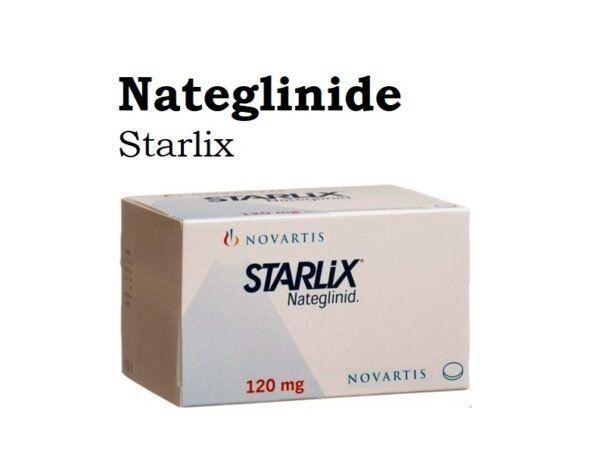
Contents
Side Effects of Starlix (nateglinide)
Type 2 diabetes usually occurs in adults and is associated with obesity and a strong family history of diabetes. Insulin is a hormone that controls blood glucose levels.
Type 2 diabetics have an inability to control blood glucose levels due to reduced insulin secretion and insulin resistance. This results in high levels of blood glucose.
Starlix stimulates pancreatic cells to produce insulin, similar to sulfonylureas like glyburide. It has a faster onset and shorter duration of action. This helps prevent rapid increases in blood glucose after meals.
Common side effects of Starlix include:
- runny nose
- cough
- upper respiratory infections
- back pain
- flu-like symptoms
- dizziness
- joint pain
Serious side effects of Starlix include low blood glucose levels (hypoglycemia). Symptoms of hypoglycemia include:
- hunger
- nausea
- tiredness
- perspiration
- headache
- heart palpitations
- numbness around the mouth
- tingling in the fingers
- tremors
- muscle weakness
- blurred vision
- cold temperature
- excessive yawning
- irritability
- confusion
- loss of consciousness
Drug interactions of Starlix include NSAIDs, aspirin, MAOIs, and beta-blockers. Dosing adjustments may be necessary when starting or stopping these drugs.
Starting or stopping certain drugs may decrease the response to Starlix and require dose adjustments:
- thiazide diuretics
- steroids
- thyroid hormone
- drugs used in emergencies such as epinephrine and albuterol
No safety and efficacy studies have been conducted in pregnant women taking Starlix, so it should not be used during pregnancy. The manufacturer recommends not administering Starlix to breastfeeding mothers due to the potential excretion of the drug in breast milk.
Important Side Effects of Starlix (nateglinide)
The most common side effects of nateglinide therapy are:
- Runny nose
- Cough
- Upper respiratory infections
- Back pain
- Flu-like symptoms
- Dizziness
- Joint pain
Another important side effect of nateglinide therapy is hypoglycemia. Symptoms of hypoglycemia include:
- Hunger
- Nausea
- Tiredness
- Perspiration
- Headache
- Heart palpitations
- Numbness around the mouth
- Tingling in the fingers
- Tremors
- Muscle weakness
- Blurred vision
- Cold temperature
- Excessive yawning
- Irritability
- Confusion
- Loss of consciousness
Starlix (nateglinide) Side Effects for Healthcare Professionals
The following serious adverse reaction is also described elsewhere in the labeling:
Clinical Trials Experience
Clinical trials showed common adverse reactions associated with Starlix. See Table 1 for details.
Table 1: Adverse Reactions other than Hypoglycemia (%) in Starlix-Treated Patients from Placebo Controlled Trials
| Placebo N=458 |
Starlix N=1441 |
|
| Preferred Term | ||
| Upper Respiratory Infection | 8.1 | 10.5 |
| Back Pain | 3.7 | 4.0 |
| Flu Symptoms | 2.6 | 3.6 |
| Dizziness | 2.2 | 3.6 |
| Arthropathy | 2.2 | 3.3 |
| Diarrhea | 3.1 | 3.2 |
| Accidental Trauma | 1.7 | 2.9 |
| Bronchitis | 2.6 | 2.7 |
| Coughing | 2.2 | 2.4 |
Hypoglycemia
Severe hypoglycemia occurred in two patients treated with Starlix. Non-severe hypoglycemia occurred in 2.4% of Starlix-treated patients and 0.4% of placebo-treated patients.
Weight Gain
Patients treated with Starlix had statistically significant mean increases in weight compared to placebo.
Laboratory Test
Increases in Uric Acid: Mean uric acid levels increased in patients treated with Starlix, both alone and in combination with other drugs.
Postmarketing Experience
The following adverse reactions have been reported during post-approval use of Starlix:
- Hypersensitivity reactions: Rash, itching, and urticaria
- Hepatobiliary Disorders: Jaundice, cholestatic hepatitis, and elevated liver enzymes
Drug Interactions with Starlix (nateglinide)
Table 2 includes a list of drugs with clinically important drug interactions when used with Starlix.
Table 2: Clinically Significant Drug Interactions with Starlix
| Drugs That May Increase the Blood-Glucose-Lowering Effect of Starlix and Susceptibility to Hypoglycemia | |
| Drugs: | NSAIDs, salicylates, MAOIs, beta-blockers, anabolic hormones, guanethidine, gymnema sylvestre, glucomannan, thioctic acid, and inhibitors of CYP2C9, alcohol |
| Intervention: | Dose reductions and increased glucose monitoring may be required when using these drugs with Starlix. |
| Drugs That May Reduce the Blood-Glucose-Lowering Effect of Starlix and Increase Susceptibility to Hyperglycemia | |
| Drugs: | Thiazides, corticosteroids, thyroid products, sympathomimetics, somatropin, somatostatin analogues, CYP inducers |
| Intervention: | Dose increases and increased glucose monitoring may be required when using these drugs with Starlix. |
| Drugs That May Blunt Signs and Symptoms of Hypoglycemia | |
| Drugs: | Beta-blockers, clonidine, guanethidine, reserpine |
| Intervention: | Increased glucose monitoring may be required when using these drugs with Starlix. |
Summary
Starlix (nateglinide) is used to lower blood glucose levels in type 2 diabetes. Common side effects include runny nose, cough, upper respiratory infections, back pain, flu-like symptoms, dizziness, and joint pain. It should not be used during pregnancy or while breastfeeding.


